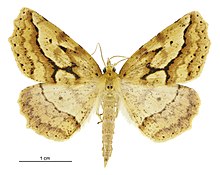Ischalis variabilis, also known as oblique-waved fern looper, is a species of moth in the family Geometridae first described by William Warren in 1895.[3][2] It is endemic to New Zealand,[1] where it is widespread in the North and South islands.[4]
| Ischalis variabilis | |
|---|---|

| |
| Female | |

| |
| Male | |
| Scientific classification | |
| Domain: | Eukaryota |
| Kingdom: | Animalia |
| Phylum: | Arthropoda |
| Class: | Insecta |
| Order: | Lepidoptera |
| Family: | Geometridae |
| Genus: | Ischalis |
| Species: | I. variabilis
|
| Binomial name | |
| Ischalis variabilis | |
| Synonyms[2] | |
| |
Taxonomy
editThis species was first described by William Warren in 1895 and originally named Polygonia variabilis.[1] In 1970 Robert W. Poole placed this species in the genus Ischalis.[5]
Description
editThere are two to three distinct transverse lines on the forewing.[6] Adults have been recorded year round, except June on the North Island. The main flight period is September to March.[7] There seem to be two generations per year, but may breed continuously during mild winters.[4] The adult moths can be collected by beating the skirt of the dead fronds of their host species.[7]
The eggs are usually deposited in January and February. [8]
Host species
editThe larvae have been recorded feeding on Cyathea and Dicksonia species including Cyathea smithii, Cyathea dealbata and Dicksonia squarrosa.[9][7] Full-grown larvae are about 32 mm long.[7] The larvae feed at night.[7] [4]
References
edit- ^ a b c "Ischalis variabilis (Warren, 1895)". www.nzor.org.nz. Landcare Research New Zealand Ltd. Retrieved 27 January 2017.
- ^ a b Dugdale , J. S. (23 September 1988). "Lepidoptera - annotated catalogue, and keys to family-group taxa". Fauna of New Zealand. 14. Department of Scientific and Industrial Research: 166. doi:10.7931/J2/FNZ.14. ISSN 0111-5383. Wikidata Q45083134.
- ^ Gordon, Dennis P., ed. (2010). New Zealand inventory of biodiversity: Kingdom animalia: chaetognatha, ecdysozoa, ichnofossils. Vol. 2. p. 459. ISBN 978-1-877257-93-3. OCLC 973607714. OL 25288394M. Wikidata Q45922947.
- ^ a b c Weintraub, Jason D.; Scoble, Malcolm J. (29 April 2004). "Lithinini (Insecta: Lepidoptera: Geometridae: Ennominae)". Fauna of New Zealand. 49: 1–48. ISSN 1179-7193. Retrieved 27 January 2017.
- ^ Robert W. Poole (1970). "Transfer of four New Zealand geometrids from the genus Azelina (Lepidoptera: Geometridae)". Proceedings of the Entomological Society of Washington. 72 (1): 135. ISSN 0013-8797. Wikidata Q123614994.
- ^ Warren, William (1895). "New species and genera of Geometridae in the Tring Museum". Novitates Zoologicae. 2: 82–159 – via Biodiversity Heritage Library.
- ^ a b c d e Andrew Crowe (2004). Life-Size Guide to New Zealand Native Ferns: Featuring the unique caterpillars which feed on them. p. 27. ISBN 0-14-301924-4. Wikidata Q115211440.
- ^ Hudson, G. V. (1928). The Butterflies and Moths of New Zealand. Wellington: Ferguson & Osborn Ltd. p. 148.
- ^ Moeed, Abdul; Meads, M. J. (1983). "Invertebrate fauna of four tree species in Orongorongo Valley, New Zealand, as revealed by trunk traps" (PDF). New Zealand Journal of Ecology. 6: 39–53.